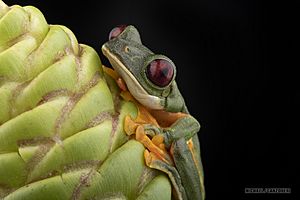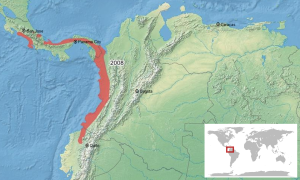Gliding tree frog facts for kids
Quick facts for kids Gliding tree frog |
|
|---|---|
 |
|
| Conservation status | |
| Scientific classification | |
 |
|
| Synonyms | |
|
The gliding tree frog (Agalychnis spurrelli) is a special kind of frog. It is known for its amazing ability to glide through the air! You can find this frog in countries like Colombia, Costa Rica, Ecuador, and Panama.
People also call it the gliding leaf frog or pink-sided tree frog. Its scientific name, spurrelli, honors a British zoologist named Herbert George Flaxman Spurrell. These frogs live in warm, wet lowland forests and sometimes in temporary swamps. Sadly, their homes are shrinking, which puts them at risk.
Contents
About the Gliding Tree Frog
What Does It Look Like?
The gliding tree frog is a medium-sized frog. Male frogs are about 4.8 to 5.6 centimeters (about 2 inches) long. Females are a bit bigger, growing to 6 to 7.2 centimeters (about 2.5 to 3 inches).
This frog has a wide head and big eyes. Its lower eyelids have a cool net-like pattern. The skin on its back and legs is smooth. But its belly has bumpy skin. Its legs are thin, and its fingers and toes have sticky pads. These pads help it climb easily.
Amazing Webbed Feet
The gliding tree frog has special webbing between its fingers and toes. Its fingers are about three-quarters webbed. Its toes are fully webbed. This webbing is super important for how it moves!
The frog's color changes too. During the day, it's a pale green. But when night comes, it turns a darker green. Its belly and the sides of its body are cream and orange.
Where Gliding Tree Frogs Live
The gliding tree frog lives in humid forests. You can find them in the lowlands of south-eastern and south-western Costa Rica. They also live in Panama, the Pacific lowlands of Colombia, and north-western Ecuador.
Life and Habits of the Gliding Tree Frog
Nighttime Adventures
The gliding tree frog is a nocturnal animal. This means it is active at night. During the day, it rests high up in the trees. At night, it moves around in the tree canopy. It climbs from branch to branch using a hand-over-hand motion.
How They Glide
This frog has a unique way to travel. When it leaps from a high spot, it spreads out its hands and feet. The wide webbing between its fingers and toes acts like a tiny parachute! This allows the frog to glide through the air. It can glide at an angle of up to 45 degrees, covering quite a distance.
Reproduction and Life Cycle
Gliding tree frogs breed quickly when the rainy season starts. They lay their eggs in small groups. These eggs are placed on the top side of leaves. These leaves hang over temporary pools of water or water-filled holes in logs.
The eggs hatch in about six days. When the tiny tadpoles hatch, they simply drop into the water below. There, they continue to grow and develop into frogs.
See also
 In Spanish: Rana deslizadora para niños
In Spanish: Rana deslizadora para niños


